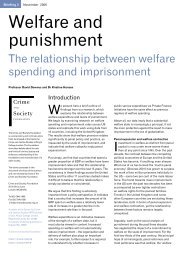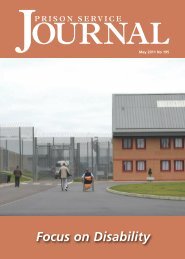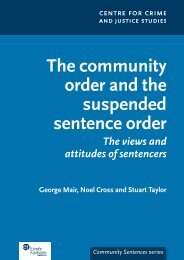PRISON SERVICE
PRISON SERVICE
PRISON SERVICE
- No tags were found...
Create successful ePaper yourself
Turn your PDF publications into a flip-book with our unique Google optimized e-Paper software.
Prolific and other Priority Offender due to his previous andcurrent offending. Has entrenched offending behaviourlargely related to general acquisitive crimes. Is a class Adrug user. No employment history. Numerous previoussentences including both custodial and communitysentences. All previous sentences have been under twelvemonths therefore not on the probation radar. He is alsoextremely unlikely to have benefited from anyprogrammes in custody due to his sentence length. Sixweeks after his sentence a sentence planning board isinitiated by Northamptonshire. A number of individualsare invited including our PPO police officers, drug workersetc. Objectives are agreed and Gerry is given a copy of hissentence plan. Referrals are made to courses within theprison to address his thinking skills, drug and alcohol use,accommodation and employment, training andeducation. Gerry was prescribed drug treatment in prisonand prior to release arrangements were made for him toattend the local drug and alcohol service as well asservices to support him withrelapse prevention. Additionallicence conditions were addedprior to release to address drugand alcohol use, PPO work andclass A drug testing.Gerry was released in March2010. He has attended allappointments (55 in total), passedtwice weekly drug tests and isattending appointments with allpartner agencies to enhance hisemployment prospects through training and education.He remains on licence.This case study is probably replicated countless timesacross the country, but I believe it is illustrative of thepivotal role that voluntary organisations and otherpartners play in our work with offenders.As we move to an era of scarce public resources,where we are faced with looking at potentially deliveringonly our core business, the necessity to work withpartners is even more imperative to ensure that resourcesare used to best effect to achieve outcomes thatcontribute to our overall business of protecting the publicthrough the safe supervision of offenders in thecommunity.Barriers to Effective ResettlementWe all know the range of factors which contribute toeffective resettlement and these have again beenrehearsed through the lectures. A place to live,employment, family ties or at least good supportmechanisms and help with health or substance misuseissues. We have known these factors for a long time andI have never heard anyone disagree with what needs to. . . we sometimesforget that we arenot resettling justthe offender but alsothe family.be done. However there is not a one size fits allresettlement provision and the needs of women, men,Black and minority ethnic, faith groups, age etc all need tobe considered in every case. We need to recognise thatresponses from some communities to the resettlement ofcertain groups are different and can fundamentally affectsuccessful resettlement for example the stigma associatedwith imprisonment if a woman with children is sent toprison, those from some faith groups. An event at HMPThe Mount recently around community links and effectiveresettlement, a prisoner said, ‘it is difficult to pick up insociety after release especially if you are pious and have along beard — that will get you insults not a job’ added tothe fear and suspicions as to why such an individual mighthave gone to prison is only likely to further alienate theindividual from his immediate community or the widercommunity. So our ability to effectively meet the differingneeds is questionable if we choose to work in isolation. Idon’t believe anyone involved in the CJS process wouldargue against multi-agencyworking however my experience isthe practice often doesn’t live upto the intention. Multi—agencywork can be time consuming anddifficult but it is effective in itschallenge to agencies to definewhat they do and the resourcesapplied it.The impact of resettlement onfamilies is often underestimatedand we sometimes forget that weare not resettling just the offender but also the family.Those groups in the community that work with familiesconsistently remind they too serve the sentence and facethe alienation from communities and suffer the stigma ofhaving a loved one in prison. How can we address thiswithin the safeguarding children responsibilities we face?We cannot forget the Rehabilitation of Offenders Actand its impact on successful resettlement. However, weneed to look closer to home about our own approach toemploying ex-offenders. Why do we believe that anyemployer will want to employ ex-offenders if we equallyare not prepared to, or our organisations have suchrestrictive policies that it would be impossible even forNelson Mandela to gain employment? We need toexamine our own policies and practices in this area.We must maintain offenders being at the centre ofwhat we do — that may be unfashionable as publicopinion appears to have become more regressive over theyears, but our contribution in preventing further victimsand reducing crime must be to work more effectively withoffenders.Through care — who cares? I believe we all do —but we just don’t remember for long enough.Issue 192 Prison Service Journal37











